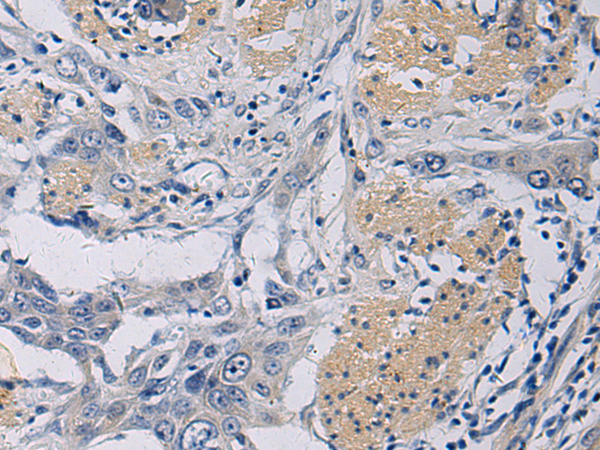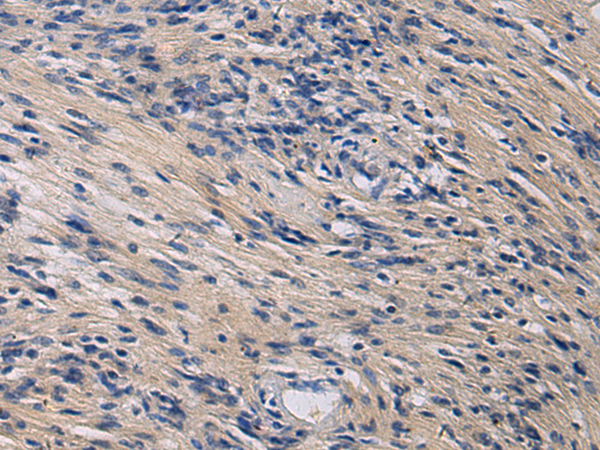

| WB | 咨询技术 | Human,Mouse,Rat |
| IF | 咨询技术 | Human,Mouse,Rat |
| IHC | 1/50-1/100 | Human,Mouse,Rat |
| ICC | 技术咨询 | Human,Mouse,Rat |
| FCM | 咨询技术 | Human,Mouse,Rat |
| Elisa | 1/2000-1/5000 | Human,Mouse,Rat |
| Aliases | EKLF; EKLF/KLF1 |
| Host/Isotype | Rabbit IgG |
| Antibody Type | Primary antibody |
| Storage | Store at 4°C short term. Aliquot and store at -20°C long term. Avoid freeze/thaw cycles. |
| Species Reactivity | Human |
| Immunogen | Synthetic peptide of human KLF1 |
| Formulation | Purified antibody in PBS with 0.05% sodium azide and 50% glycerol. |
+ +
以下是3篇关于KLF1抗体的参考文献及其摘要概括:
1. **《Krüppel-like factor 1 (KLF1) mutations in moderate congenital hemolytic anemia》**
- **作者**:Arnaud, L. 等
- **摘要**:该研究利用KLF1特异性抗体进行免疫荧光染色,揭示了KLF1基因突变导致红系分化异常,并验证抗体在患者外周血细胞中检测KLF1蛋白表达的可靠性,为贫血机制研究提供依据。
2. **《KLF1 directly coordinates the activation of embryonic and fetal globin genes in human erythroid cells》**
- **作者**:Tallack, M.R. 等
- **摘要**:通过ChIP-seq和KLF1抗体染色,证明KLF1通过结合胚胎和胎儿型珠蛋白基因启动子调控其表达,抗体在染色质免疫共沉淀中表现出高特异性,支持其在表观遗传学研究中的应用。
3. **《A global role for KLF1 in erythropoiesis revealed by ChIP-seq in primary erythroid cells》**
- **作者**:Bottardi, S. 等
- **摘要**:研究使用KLF1抗体进行全基因组结合位点分析,发现KLF1在红系细胞中广泛调控血红蛋白合成相关基因,验证了该抗体在ChIP实验中的高效性和低交叉反应性。
这些文献均涉及KLF1抗体在蛋白质定位、基因调控研究及疾病模型中的关键应用。
KLF1 (Krüppel-like factor 1), also known as erythroid Krüppel-like factor (EKLF), is a transcription factor critical for erythroid lineage development and hemoglobin regulation. It binds to DNA through its zinc finger domains, activating genes essential for red blood cell maturation, such as β-globin, and coordinating the switch from fetal to adult hemoglobin during development. KLF1 mutations are linked to hematologic disorders like congenital dyserythropoietic anemia and hereditary persistence of fetal hemoglobin (HPFH).
KLF1 antibodies are vital tools for studying its expression, localization, and function in erythropoiesis. These antibodies are widely used in techniques like Western blotting, immunofluorescence, chromatin immunoprecipitation (ChIP), and flow cytometry to detect KLF1 protein levels, assess DNA-binding activity, or identify its interaction partners. Researchers also utilize KLF1 antibodies to investigate dysregulated erythropoiesis in diseases or model organisms (e.g., mice with KLF1 knockout). Specificity and validation (e.g., using knockout controls) are crucial, as KLF1 shares structural homology with other Krüppel-like family members. Commercial KLF1 antibodies are typically raised against conserved epitopes in human, mouse, or rat variants, enabling cross-species applications. Their role in advancing understanding of erythroid disorders and potential therapeutic strategies underscores their importance in hematology research.
×